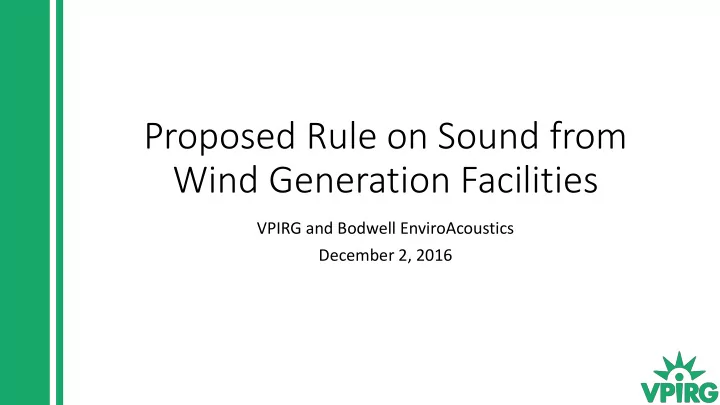

Proposed Rule on Sound from Wind Generation Facilities VPIRG and Bodwell EnviroAcoustics December 2, 2016
Background & Issues • Lack of consistent protocol for pre-construction modeling and post- construction operations testing • Interior standard creates difficulty isolating wind turbine sound, disruptive to project neighbors • Turbine shutdowns/ambient noise are imprecise methods for gathering sound data • Complaint process is confusing and costly
VPIRG/BEA Proposal 1. Establish accurate and reliable methodologies • Conservative modeling based on manufacturer’s sound level data • Compliance measurements using test protocol designed to measure conditions when wind turbine sound is most prominent 2. Establish metrics and limits • Based on appropriate use of independent studies
Modeling • Terrain-based acoustic model of the project • Specify parameters including: • Ground absorption including acoustically reflective surfaces • Standard atmospheric conditions • All turbines at full rated sound output • No attenuation for trees and foliage • Uncertainty based on turbine manufacturer warranty and model uncertainty assumes “worst - case” sound levels
Operations Test Protocol • Monitor locations with highest potential to exceed limits (or proxy): • Predominantly downwind (within 45°) • Generally nearest residences to wind turbines • Similar elevations & line of sight • Rigorous protocol conditions • Notification and concurrence of DPS of times and locations in advance.
Operations Test Protocol (cont.) • Required Test Conditions • Periods when wind turbine sound most prominent • Surface average wind speeds (10m) ≤6mph • Upper winds sufficient to generate maximum continuous rated sound power from nearest wind turbines • Typically occurs during nighttime. Daytime associated with atmospheric instability and high turbulence periods 10 m Wind Sensor
Protocol vs Variable Test Conditions
Ambient Adjustment Issues • Site/wind conditions can change significantly between operating and shutdown conditions • Subtracting ambient sound levels introduces potential for significant errors • Results in extra expense and power loss • Measurements under protocol conditions provide more accurate/cleaner sound data for turbine operations • Eliminates “sound data” confusion for quantifying turbine sound levels and evaluating compliance
Limits & Method • Need to be based on independent, factual community noise studies • Those studies need to be applied correctly to support proper use of sound metrics and time periods Proposed Limit: 45 dB(A) L eq 10 min exterior • Supported by ANSI, ISO, EPA, and WHO standards and recommended limits
Stetson II Analysis • Highest measured sound level applied to full year of turbine operations • Illustrated that a limit of 45 dB(A) L eq, based on conservative modeling, successfully met recommended limits: • WHO: 40 L night,outside annual • EPA: 45 L dn
Setbacks 3000 ft Setbacks do not 1500 ft correlate with sound levels
Conclusion • Proposal based on proven sound modeling and testing resolves major technical issues • Enables appropriate limits and metrics based on independent studies • Consistent methodologies will benefit all stakeholders • Meets Stated Goals: enforceability, predictability, reliability of data
Recommend
More recommend